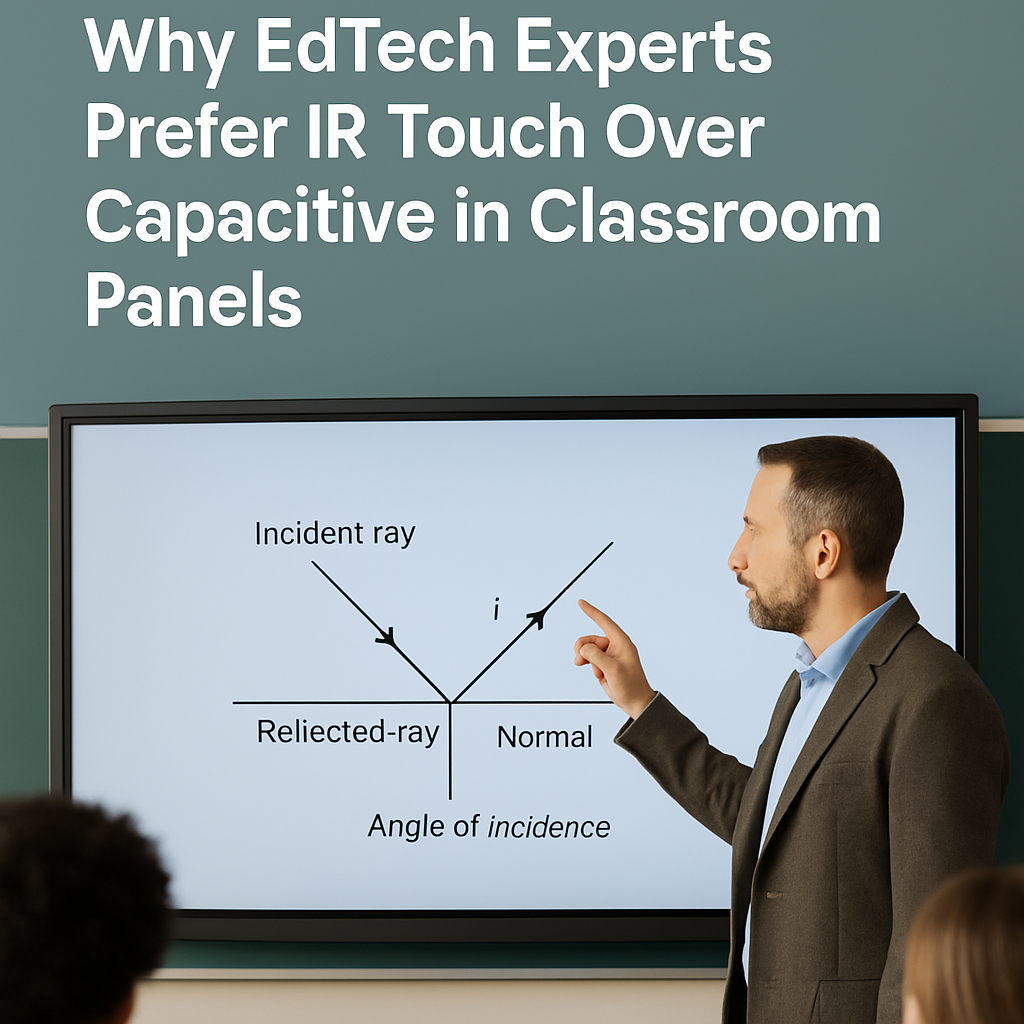Why EdTech Experts Prefer IR Touch Over Capacitive in Classroom Panels

As digital classrooms continue to evolve in India, choosing the right interactive touch panel is becoming a critical decision for schools and higher education institutions. Among the most debated specifications today is the type of touch technology: Infrared (IR) versus Capacitive. While both have their use cases, a growing number of educators are leaning toward IR for large classroom environments. But why?
Let’s unpack the reasoning from the lens of EdTech experts who’ve worked closely with interactive digital boards across multiple institutions.
What Is IR Touch, and How Does It Work in Classrooms?
IR touch panels use a frame of infrared sensors to detect touch. When you interrupt the light beams with a finger or stylus, the panel recognizes it as an input. Unlike capacitive touch, which relies on electrical conductivity (like smartphone screens), IR touch doesn’t require direct skin contact.
This makes IR-based interactive display panels far more flexible for classroom settings. Gloves, styluses, or even a regular pen cap can trigger input. This isn't a small advantage. It shapes how teachers and students interact with technology every day.
Comparing IR-Based Interactive Touch Panels With Capacitive Options
1. Larger Displays Need IR to Maintain Precision
Most classrooms in India today are shifting toward bigger displays, 85 to 100 inches and above, to improve visibility in mid- to large-sized classrooms. According to AV experts in Delhi and Bengaluru, capacitive panels struggle with input accuracy on these larger screens. That’s where IR shines.
For instance, infrared touch scales more accurately across large surfaces. When students or teachers write on the edge of a 100-inch panel, the IR sensors still catch the input perfectly. This matters when you're annotating a diagram, solving equations, or highlighting keywords, small inaccuracies can derail the learning flow.
2. IR Panels Are Designed for Tougher Environments

Capacitive panels, though sleek and responsive, are delicate. A scratch, a crack, or even heavy dust can affect performance. In contrast, IR touch panels are built to survive real-world classroom conditions.
Dust from open windows, students tapping the screen with pens, or the occasional bump from a school bag—IR handles it all without degrading. That’s why many EdTech experts recommend IR-based interactive touch panels for Indian classrooms, especially in rural and semi-urban areas where controlled environments are a luxury.
3. Greater Flexibility with Input Tools
Another reason IR wins? It supports multiple input methods.
In a typical school setup, teachers use everything from styluses to fingertips, sometimes even rulers, to interact with smart boards. With capacitive, you’re limited, no gloves, no regular stylus, and definitely no plastic object support.
IR-based interactive touch panels allow:
- Finger and stylus input interchangeably
- Multi-user interaction
- Input even with gloves (important during winters in northern India)
That’s classroom-ready flexibility.
4. Lower Cost Without Compromising on Experience
Budget is always part of the conversation. The average smart board for teaching price in India ranges from ₹50,000 to ₹2,50,000 depending on brand and features. Capacitive models sit on the higher end of that spectrum and not always with a justifiable performance gap.
When comparing total classroom deployment cost, IR-based interactive touch panels deliver better value for money. You get multi-touch, stylus support, large format capability and you’re still well within budget. For large-scale rollouts across multiple classrooms, this cost efficiency becomes a major decision-making factor.
5. Easier to Maintain and Troubleshoot
Capacitive panels require precise calibration and are harder to service locally. IR panels, on the other hand, are easier to troubleshoot and maintain especially with plug-and-play models like Roombr, which combine simplicity with smart classroom capabilities.
If one IR sensor malfunctions, it doesn’t shut down the whole panel. For schools without full-time IT staff, that’s a practical advantage. Many education administrators in states like Tamil Nadu and Punjab now specifically ask for IR-based interactive display panels due to this ease of maintenance.
6. More Classroom-Friendly Over Time
Not every classroom in India runs like a demo room. Panels are used daily, sometimes for 6–8 hours straight. Over time, capacitive panels may show input lag or reduced sensitivity. IR-based interactive touch panels tend to hold up better under sustained classroom use, especially when combined with robust specs like those found in Roombr’s all-in-one units.
Also, IR panels typically have lower power consumption and longer component life, both essential for cost-conscious institutions.
When Might Capacitive Panels Still Make Sense?
To be fair, capacitive technology isn’t without strengths. It offers smoother gestures, works well in smaller screens, and has better palm rejection for artistic applications. This makes it suitable for tablet-based learning or design-focused curricula.
But for mainstream education, where you need durability, flexibility, and large-scale usability, IR touch clearly wins.
Final Thoughts
Choosing the right interactive touch panel isn’t just about specs, it’s about classroom realities. Experts in the Indian education sector agree: IR touch offers more durability, flexibility, and value for the typical school or college environment.
If you're evaluating smart board solutions this year, ask vendors:
- Does the panel support IR touch?
- Can it handle stylus, finger, and multi-touch inputs?
- What’s the price vs. performance trade-off?
Roombr’s interactive touch panel solution, for instance, combines IR touch with high-speed processing, lecture recording, dual cameras, and instant annotation, all at a price that fits real Indian classrooms.
Upgrade to IR-Based Interactive Touch Panel Solution
Transform your classrooms with durable, high-performance IR-based interactive touch panel solutions built for Indian education. Replace unreliable technology with robust, classroom-ready solutions designed for effective and modern teaching.
Explore Roombr’s classroom-ready solutions designed for schools and colleges that demand reliability, clarity, and real value. Book a demo today.
Foziya Abuwala
Share
Step Into the future of
Education with Roombr

















